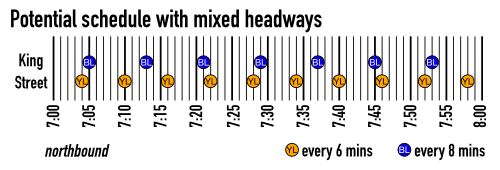Metro might cut Green Line service because of worries about train spacing

Photo by Matthew Wilkinson on Flickr.
Metro’s proposal to improve the Blue Line by cutting the Yellow and Green Lines hinges on officials’ insistence that Metro trains run “evenly spaced.” What does that really mean, is it actually necessary, and will this change help or hurt most riders?
The problem at hand is that if Metro runs the Blue, Orange, and Silver Lines every eight minutes, but the Green and Yellow every six minutes, the Blue and Yellow Lines can’t share the tracks evenly on the shared segment in Alexandria and South Arlington.
In 2012, in anticipation of the coming Silver Line, WMATA starting running Blue Line trains less frequently. Blue trains now run every 12 minutes during rush hour. The cuts have led to overcrowding on the Blue Line, which WMATA is hoping to resolve.
But since the shared Blue/Orange/Silver subway through DC is running at capacity, the only way to add Blue Line trains is to cut back the number of Orange and Silver Line trains. The agency has proposed reducing Orange and Silver Line train spacing from six minutes to eight and the Blue Line from 12 minutes to eight.
However, WMATA has also proposed cutting Green and Yellow Line trains from six to eight minute frequencies. As we pointed out last week, those cuts may be unnecessary, and will actually result in 50% less rail service north of Mount Vernon Square.
What’s behind these cuts?
As it turns out, Metro is concerned about unbalanced headways in Alexandria and South Arlington if the Blue comes every eight minutes and the Yellow comes every six.
If both lines run every eight minutes, Metro could easily space the trains at four-minute intervals. But with one line running every six and another every eight, the trains can’t be evenly spaced. The time between trains will fluctuate between one and six minutes. And periodically, two Yellows will come through between Blues.
And if the Yellow has to run less to interface (share tracks) with the Blue, then so does the Green.
For a whole lot of people, spacing between lines isn’t all that important
How important is balance between the Blue and Yellow, especially in comparison to the number of other riders inconvenienced by the unnecessary cuts?
On the shared Blue/Yellow line in Virginia, most riders are waiting for either the Blue or Yellow, not just for whichever comes first. That’s because the lines serve different markets. Someone traveling from Braddock Road to Farragut West doesn’t care about how the Yellow is spaced relative to the Blue, since the Yellow won’t help her get to work.
In fact, during the morning peak, only 11.9% of the customers who board at one of the shared stations (about 2,600) stay within that segment. The other 88.1% of riders probably specifically want the Blue or the Yellow.
Over 56,000 customers use a Green Line train during the AM peak. Another 7,000 board or alight at Eisenhower Avenue or Huntington. Those 63,000 customers will see their train service cut so that the 2,600 customers traveling within the shared Blue/Yellow segment see even headways.
Metro’s concerns are likely deeper than just customer convenience
As you can see from the graphic above, the Blue and Yellow trains come within one minute of each other repeatedly throughout the peak period. That’s barely manageable, and it depends on things going smoothly.
With this schedule, even a slight delay can ripple through across the system. On the shared Blue/Yellow segment, for example, if a Blue misses its appropriated space, there might be a six-minute gap behind the Yellow. But when that Blue Line train gets to Rosslyn, it has to find a slot, and it might be hard to fit the train in smoothly if there’s not one open.
Since Metro is proposing to reduce the number of trains through Rosslyn, that will be easier than today, but it could still be problematic.
If the Orange and Silver Lines are spaced four minutes apart, a Blue can fit in between them, with two minutes on either side. That leaves the next gap at four minutes. So it’s possible that if a Blue Line misses its slot, it can simply fit into the next gap.
Metro faces a difficult task in figuring out how to balance service on the four lines that share with the Blue Line. In the end, the only permanent solution is likely to be some form of a separated Blue Line. But a new subway across downtown is decades in the future. Even a separated Rosslyn station for Blue trains remains an unfunded dream.
Hopefully, WMATA will find a way to rebalance service on the Blue, Orange, and Silver Lines without negatively impacting Green and Yellow Line riders unnecessarily.


